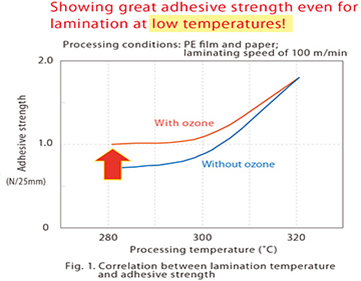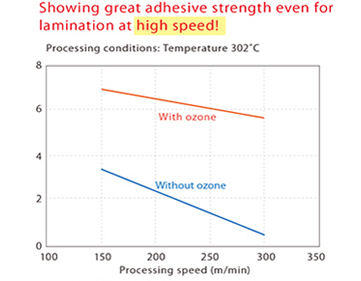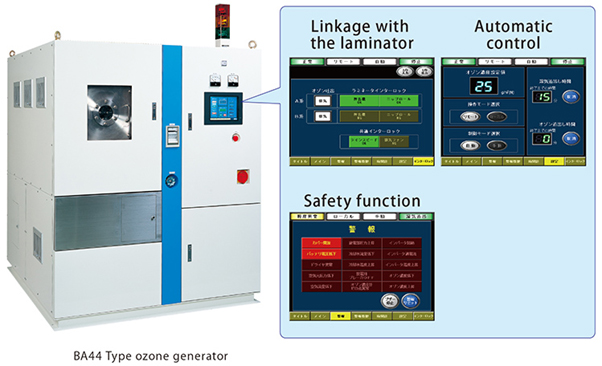Features of ozone
Ozone is expressed as O₃ by the chemical symbol. Its oxidization is the strongest next to fluorine among natural elements and it has unique pungent smell. Ozone is very unstable gas, decomposing itself under normal temperature trying to return to the state of oxygen. Ozone can be generated by discharging electricity in dry air or oxygen, by applying ultraviolet, or by generating oxygen from electrolytes and converting it to ozone. Safety of ozone
If the concentration of ozone is high, it is toxic and harmful to people. Therefore, it is important to know the danger of ozone and set up measures for expected accidents.
To prevent the harm of ozone, the Japan Society for Occupational Health has set the permissible concentration of ozone in the work environment as 0.1ppm (in 8 hours).
| Ozone concentration (ppm) | Odor | ||
|---|---|---|---|
| 0.01~0.02 | Odor | ||
| 0.1 | Strong odor, pungent to the nose or throat. | ||
| 0.2~0.5 | In 3 to 6 hour exposure, the vision lowers. | ||
| 0.5 | Obviously pungent to the upper bronchial tube. | ||
| 1.0~2.0 | In 2 hours exposure, there is a headache, pain in the chest, thirst and coughing of the upper bronchial tube. If the exposure is repeated, people get chronic poisoning | ||
| 5~10 | Increase of pulse can be noted, causing lung edema. | ||
| 15~20 | Small animals die in 2 hours. | ||
| 50 | People’s life is endangered in 1 hour | ||
Main use of ozone
1) Sterilization
The sterilizing effect of ozone is the same as the sterilization of oxyflu, i.e. hydrogen peroxide solution which becomes toxic as it tries to return to water. However, ozone does not leave toxic substance because it remains as oxygen after the reaction.
2) Deodorization
Ozone deodorizes smells with its strong oxidization effect. If ozone contacts with odor elements (ammonia, trim ethylamine), the odor elements are decomposed to non-smelling substances by the chemical reaction of ozone’s oxidizing power.
3) Depolarization
Ozone is able to cleave the molecular double binding of organic coloring components and decolor it. Currently, chlorine is used to bleach pulp, but it leaves a great deal of organic compounds. It is expected that the process shifts to ozone bleaching hereafter.
4) Decomposition of organic matter
Ozone cleaves molecular double binging and causes COD and TOC to decrease
Improvement of the quality of packaging materials
Enhancement of the productivity of lamination using ozone
- Effects of ozone
- • Increased adhesive strength
- • Reduced damage of materials; reduced consumption of energy due to decreased temperature required for processing
- • Increased processing speed
- • Reduced plastic odor
- • Decreased loss of materials; improved workability due to the shortened air-gap
Comparison between with and without ozone for extrusion lamination


Application examples
- • Foods (packages for candies, soups, etc.)
- • Medical care (packages for pharmaceuticals, etc.)
- • Construction materials (wallpapers, etc.)
Ozone generation system for lamination


Features of our ozone generators for lamination
- • High concentration and flow rate, suitable for lamination
- • Safety-first design
- • Automatic control in linkage with the laminator
- • Abundant delivery records
| Models | Ozone gas generation g/h | Ozone gas flow rate m³/h(N) |
|---|---|---|
| BA4-80-25 | 80 | 3.2 |
| BA7-140-25 | 140 | 5.6 |
| BA7-140-25 | 240 | 9.6 |
| BA20-380-25 | 380 | 15.2 |
| BA29-540-25 | 540 | 21.6 |
| BA44-800-25 | 800 | 32 |
